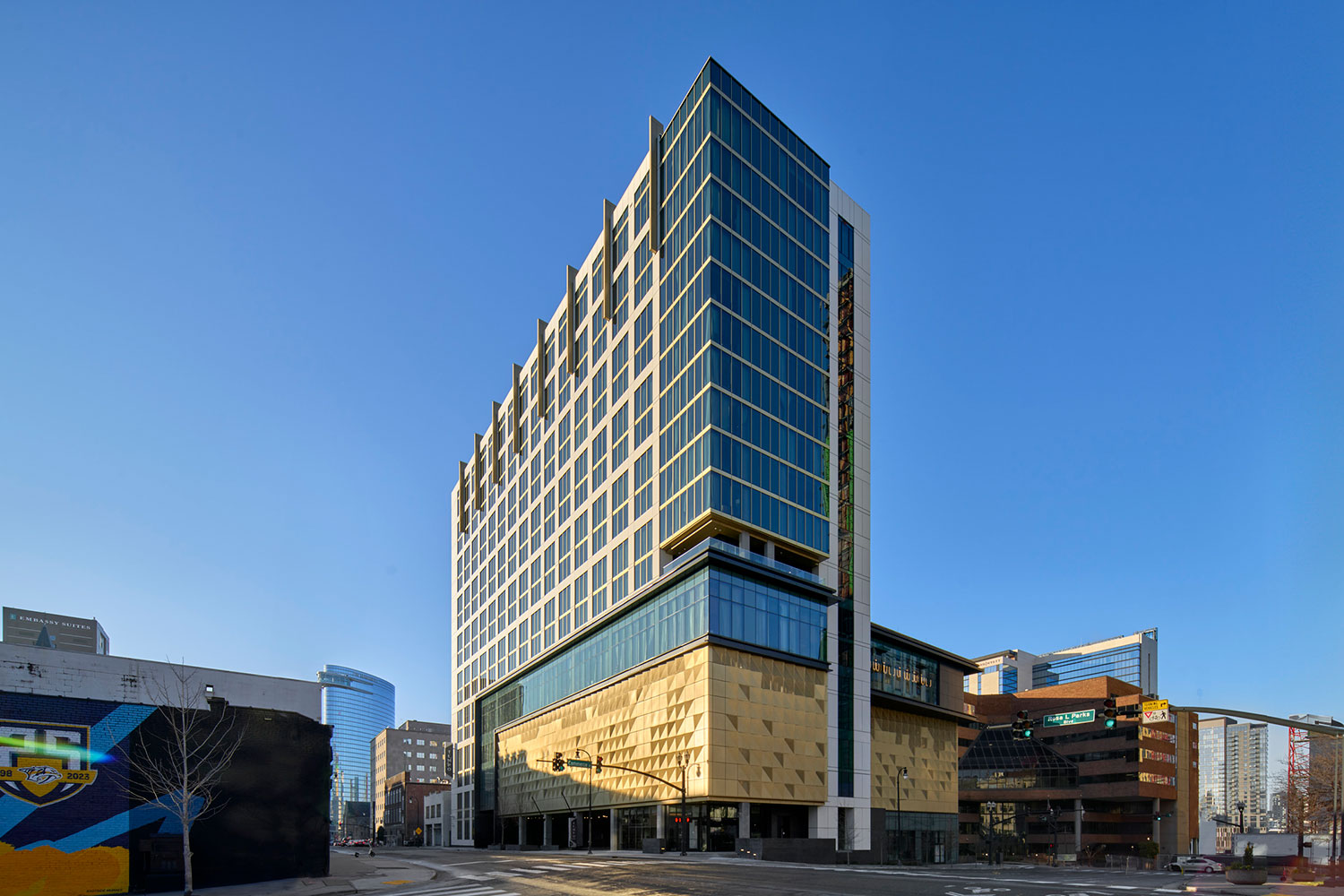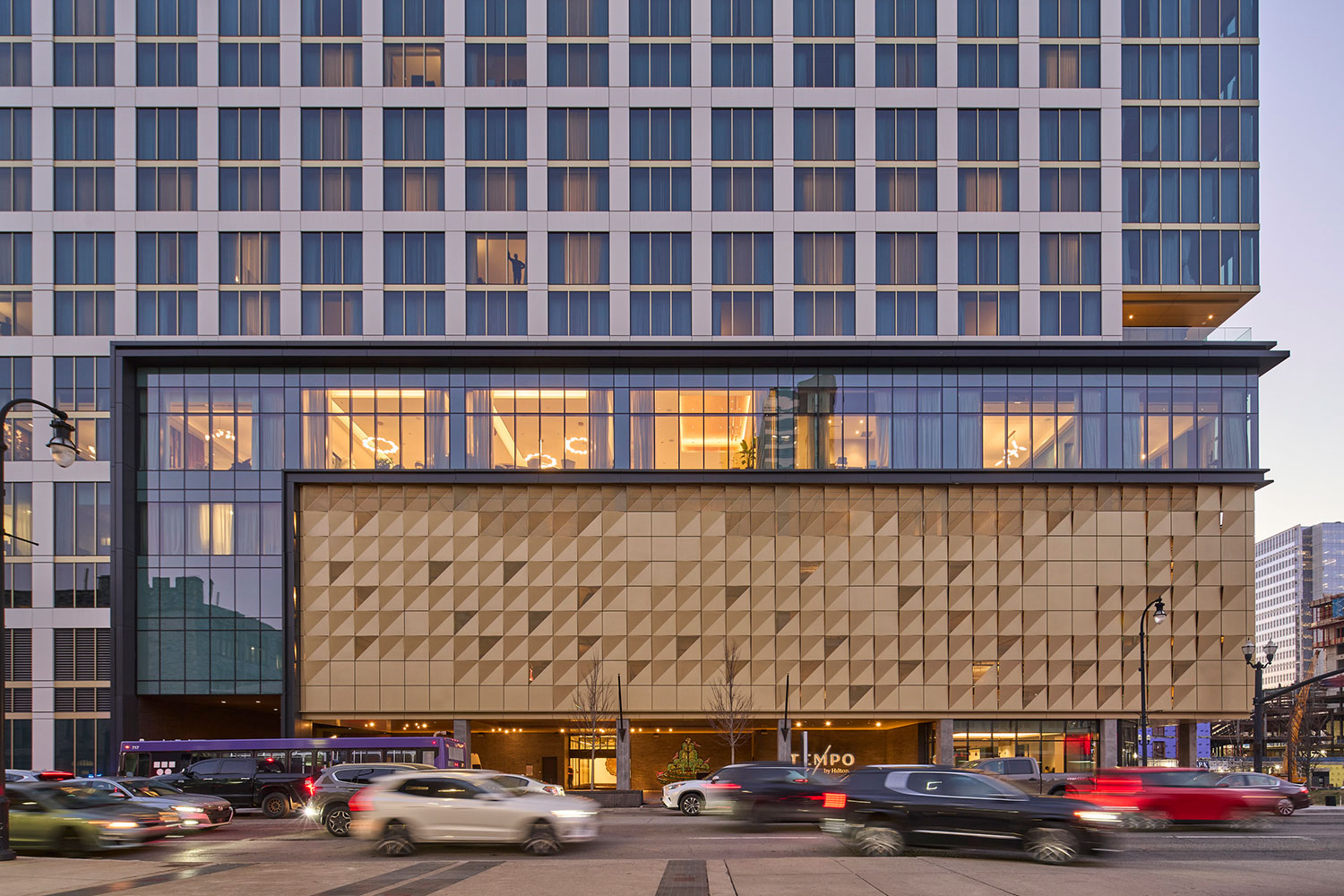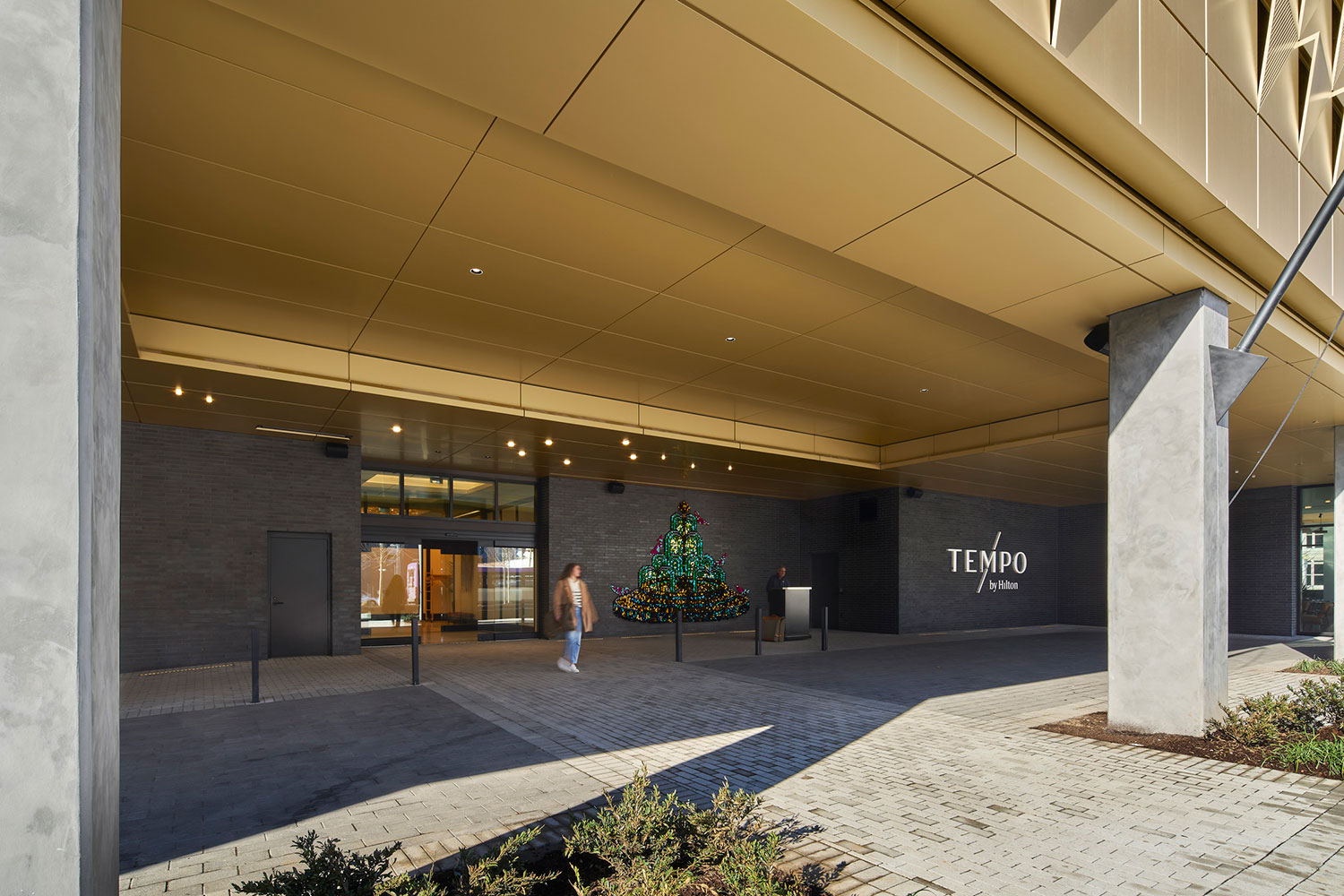A New Tempo in Hospitality: Inside Tempo by Hilton Nashville
Located in the vibrant heart of downtown Nashville, Tempo by Hilton Nashville Downtown sits just steps away from Broadway, surrounded by shops, restaurants and entertainment venues. Here, both locals and travelers find a bustling hub for socializing and hosting events, alongside chic accommodations designed for relaxation and rejuvenation.
Preserving the Past, Building the Future
HRI Hospitality has been a longstanding partner on projects including historic renovations and urban infill. The Tempo site is situated one block from Nashville’s main tourist thoroughfare–Broadway. The significant notable nature of the site and surrounding historic structures married with the owner’s interest in renovation work drove the design toward a conceptual reimagining of historic precedents.
In Nashville, as with many growing cities, architectural treasures have been lost to new development and growth. Our design team chose to reflect on some of those prior buildings on nearby sites and draw inspiration from their components.
An exemplary Art Deco building, the Sudekum Tower, was previously located near this site. Designed by Marr and Holman architects, this structure served as a major inspiration for the Tempo by Hilton project. ESa proposed utilizing the Sudekum Tower as a precedent, not only for its aesthetic appeal but also for its significance in Nashville’s cultural narrative. The historic Tennessee Theater was located at the base of the Sudekum Tower. This vibrant building featured hallmarks of Art Deco style in ornamental touches, chrome detailing and expressive gargoyles. At the ground plane, the Tennessee Theater’s marquee welcomed visitors in with a unique lighting design.
The design for the Tempo by Hilton was inspired by this and similar art deco styles as evidenced in its fenestration, massing, and detailing–paying homage to a lost part of Nashville’s skyline. The project evokes this marquee entry using warm lighting and bold colors into the building’s entry and garage screening. On the exterior, the vibrant color palette nods to the Calacatta gold marble that once adored the Sudekum Tower’s lobby prior to the Tennessee Theater’s opening. Additionally, the vertical patterning and proportions of the windows reflect the tower’s striking Art Deco façade.
Harmonizing Function and Form
The Tempo by Hilton hotel evolved through many iterations to come to the final massing and design. Originally conceptualized as a residential high rise, this project saw shifts as markets changed and the country underwent a pandemic. Redesign efforts saw this development as a mixed-use project, dual brand hotel, and ultimately the owner’s goals were realized in a single brand hotel. Given the owner’s target hotel unit count, the project’s massing developed into an L-shape tower.
The prominent site at the corner of Rosa L. Parks Boulevard and Commerce Street presented challenges with this form. To achieve the desired density, the project needed to span over an adjacent alley dividing the site. The project team worked with the city and the mayor’s office to successfully allow for guestrooms and parking spaces to pass over the alley connecting Rosa L. Parks Boulevard with Ninth Avenue. This strategic decision resulted in a sleeker and more engaging ground-level experience for pedestrians, while providing added amenities and meeting spaces for guests. Elevating the primary lobby and amenity level to the fifth floor via the alley bridge offers visitors sweeping views of downtown. Externally, this connection is visually expressed through a bar of floor-to-ceiling windows that separate the podium and tower, delineating the podium from the tower and enhancing the building’s aesthetic appeal.

The Art Deco of it All
Leveraging our client’s expertise in preservation architecture, our design team emphasized the importance of creating order and harmony within the context of the site’s historical background. The design focuses on activating the building’s artful facade and creating a visually striking presence, particularly at night. Utilizing glass and a prominent band running through the structure, the design team envisioned a captivating display that illuminates the building’s form after dark, resembling a glowing gold box atop the structure. A deliberate segmentation of the building’s design serves to delineate different functions, with the parking garage concept receiving special attention as a personification of the Tennessee Theater marquee.

The incorporation of gold accents at the base of the structure, along with public spaces throughout, provides a cohesive design language that transitions effortlessly into the tower above. The decision to extend decorative fins at the top of the structure serves both an aesthetic and practical purpose, offering a recognizable landmark and aiding wayfinding for visitors navigating Nashville. Distinctive entry sequence represented by the porte-cochère welcomes hotel patrons in to the “motor lobby” – creating a dynamic space where guests can check in, access amenities, and socialize effectively. By consolidating all programmatic functions on the fifth floor, the team streamlined the guest experience and enhanced wayfinding. The flexibility of the fifth-floor space allows for seamless transitions between different activities with the goal that the area remains vibrant and engaging throughout the day. The connectivity between the lobby and the outdoors, emphasizes the importance of providing guests with an uninterrupted view of downtown.

Echoes of Music Legends
The project’s goal of honoring Nashville culture extends to the interior design. On the interiors, the intent was to infuse the narrative with elements reminiscent of Nashville’s cultural heyday, particularly during the 1970’s and perhaps more specifically in 1973 when the Grammys were hosted in the Tennessee Theater. The project design concept personified a fictional musical character by the name of Mary Louise, whose story unfolds within the project’s design. Wimberly, who served as interior designers for the hotel, contributed to the project’s vision, aiming to showcase Mary Louise’s experiences through the project’s spaces. The ground floor entrance projects a warm theater-like glow, while the fifth-floor lobby resembles a cozy personal living room, transitioning to intimate guest rooms adorned with personal touches reflecting Mary Louise’s imagined life and achievements – such as photographs capturing pivotal moments like winning her first Grammy. The project honors Nashville’s rich musical heritage, offering guests an immersive journey through the imagined world of Mary Louise and the city’s vibrant past.